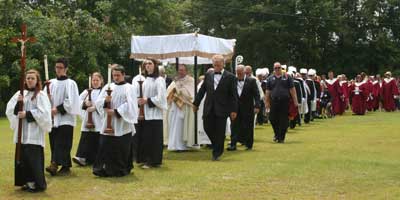

LEXINGTON—Members of Corpus Christi Church took part in a meaningful celebration on June 22 to commemorate the 750th anniversary of Corpus Christi, the feast day that is also their parish namesake.
Hundreds turned out for a Mass celebrated by Bishop Robert E. Guglielmone and an elaborate eucharistic procession that wound its way around the parish property off Augusta Road.

Father Raymond Carlo, the pastor, said it was a wonderful way for parishioners to celebrate the meaning of the Eucharist.
“The Eucharist is the source and summit of our faith, it is at the heart of our faith,” Father Carlo said. “Only our Church has the teaching of transubstantiation, the real presence of Christ, and we wanted to celebrate that.”
Corpus Christi, Latin for “Body of Christ,” is celebrated each year on Sunday, two weeks after Pentecost.
According to a written history prepared by Father Carlo for the celebration, the feast was first promulgated by Pope Urban IV in 1264.
It started thanks to a priest named Peter of Prague, who came to Rome on pilgrimage in 1263. At the time, he was struggling with doubt about whether Christ was really present in the consecrated host, even though Church teaching stresses the real presence of Jesus in the Eucharist as central to the faith.
 Peter stopped in the town of Bolsena in the Umbria region of Italy, where he celebrated Mass in the Church of St. Christina.
Peter stopped in the town of Bolsena in the Umbria region of Italy, where he celebrated Mass in the Church of St. Christina.
According to the history, “when he began to speak the words of consecration, blood began to seep from the consecrated host and trickle over his fingers and hands and onto the altar and the white altar cloth.”
Peter first tried to hide the blood, but then halted Mass and asked to be taken to the city of Orvieto, where the pope lived at the time.
Pope Urban IV then sent emissaries to Bolsena to investigate the priest’s story. When it was confirmed, he had the host and the blood-stained linen brought to Orvieto, where they were placed in the cathedral as relics.
The pontiff then commissioned St. Thomas Aquinas to compose an order of worship and prayers that honor the Holy Eucharist.
Two of these chants are still used today, one on Holy Thursday and also the “Tantum Ergo” sung during Benediction. Then, in August of 1264, Urban IV proclaimed a papal bull that instituted the feast of Corpus Christi.
Traditionally, Catholics in Europe and the U.S. have observed Corpus Christi with Eucharistic processions along town and city streets, followed by Benediction. This was exactly how Father Carlo and others planned the Lexington event.
After the 11 a.m. Mass, Bishop Guglielmone held the Eucharist aloft in a monstrance while walking under an elaborate canopy held by men of the Knights of Columbus. He was accompanied by Father Carlo and the parish deacons, and followed by a large crowd of about 200 that included members of the choir who prayed, sang and played handbells during the procession.


They all made their way to four prayer stations set up around the church property, including a spot tucked away down a shady woodland path and a grotto to Mary in the back of the church.
The stations were set up and decorated by the parish youth group, the women’s group, the Knights and the Legion of Mary.
Bishop Guglielmone incensed the monstrance and prayers were said at each stop.
At the end, participants filed back into the church for Benediction.
 Afterward, everyone enjoyed a meal that included an elaborately decorated cake donated by a parishioner to commemorate the feast.
Afterward, everyone enjoyed a meal that included an elaborately decorated cake donated by a parishioner to commemorate the feast.
Behind the cake stood a painting of a chalice and host done by Shannon Neusch, a convert who came into the church in 2009. She said the painting took about 13 hours and offered a way for her to honor the day.
“For me, Corpus Christi represents a lot of what I felt coming into the Catholic faith,” she said. “I feel like becoming Catholic was the first time I ever really understood the whole Christian experience, and the Eucharist is a big part of that.”
Sandy Butler of Lexington said she loved the celebration because it is a way of bringing back traditions she remembers from her Catholic childhood.
“This celebration really brings back to us why we receive Communion and what it truly means,” she said. “A lot of times we take it for granted.”
